Artificial Intelligence and Robotics: Future of Occupations
VerifiedAdded on 2021/06/16
|14
|3509
|108
Report
AI Summary
This report delves into the profound impact of artificial intelligence (AI) and robotics on the future of work, particularly within the Australian context. It examines the potential displacement of human workers across several key professions, including teachers, taxi drivers, and doctors. The report analyzes current demographic trends within these occupations, assesses the likely effects of automation and AI-driven technologies, and projects how these roles might evolve or disappear in the coming decades. The analysis considers factors such as the increasing efficiency of AI, the development of humanoid machines, and the potential for both economic disruption and new opportunities. The report highlights the potential for job losses due to automation, the need for adaptation, and the social and economic implications of these technological advancements. It underscores the importance of understanding the evolving landscape of work and preparing for a future where AI and robotics play an increasingly significant role.
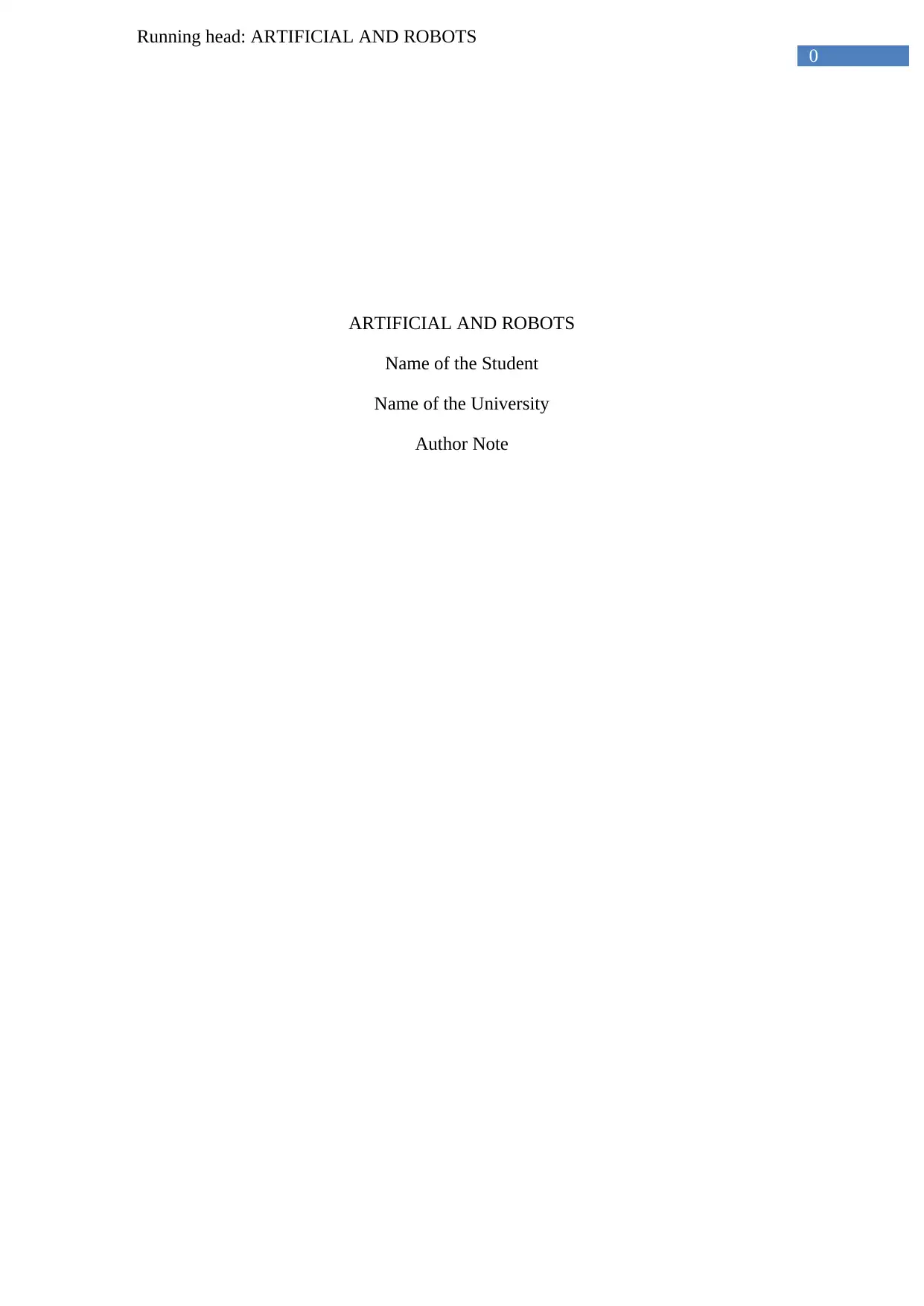
0
Running head: ARTIFICIAL AND ROBOTS
ARTIFICIAL AND ROBOTS
Name of the Student
Name of the University
Author Note
Running head: ARTIFICIAL AND ROBOTS
ARTIFICIAL AND ROBOTS
Name of the Student
Name of the University
Author Note
Paraphrase This Document
Need a fresh take? Get an instant paraphrase of this document with our AI Paraphraser
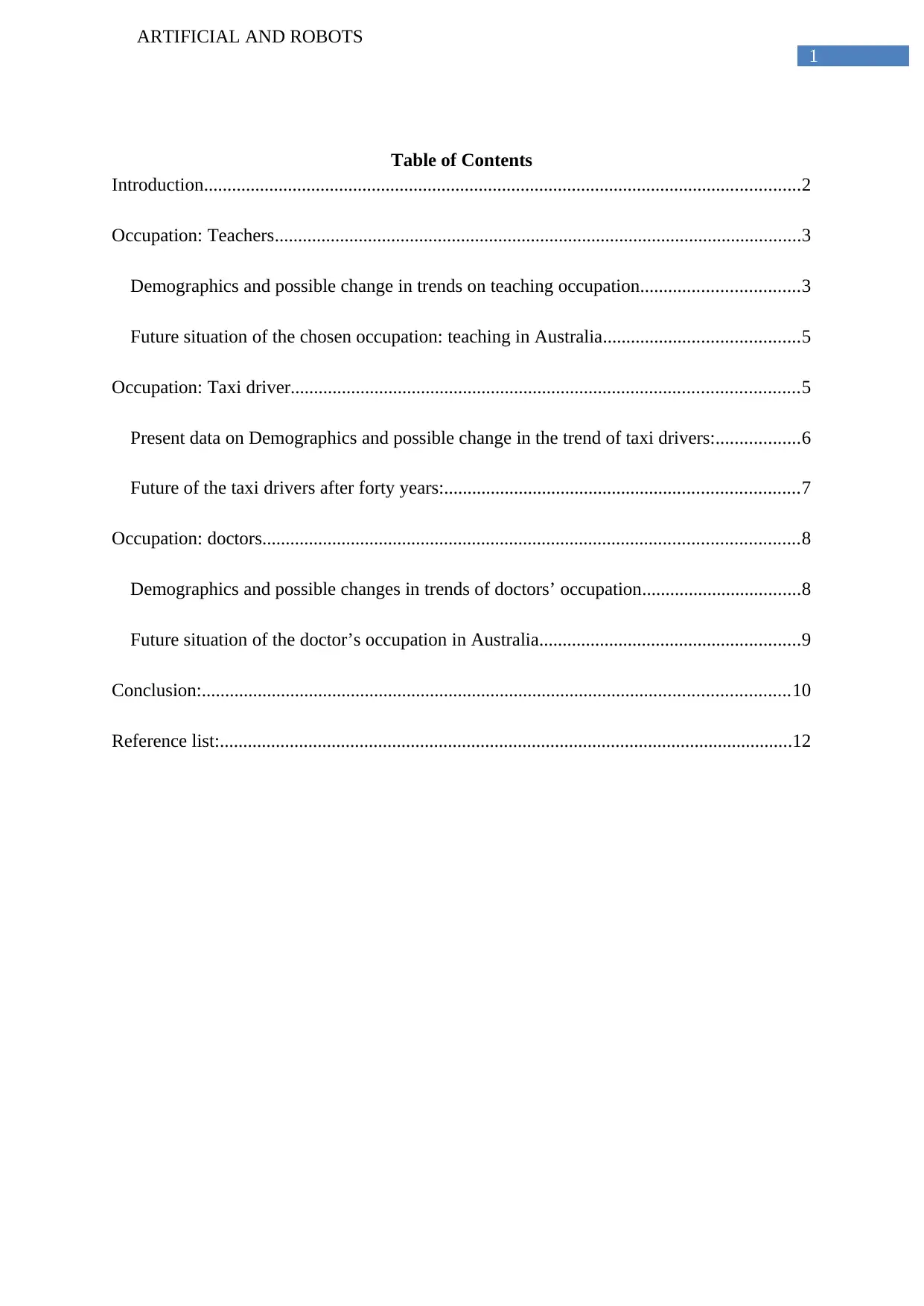
1
ARTIFICIAL AND ROBOTS
Table of Contents
Introduction................................................................................................................................2
Occupation: Teachers.................................................................................................................3
Demographics and possible change in trends on teaching occupation..................................3
Future situation of the chosen occupation: teaching in Australia..........................................5
Occupation: Taxi driver.............................................................................................................5
Present data on Demographics and possible change in the trend of taxi drivers:..................6
Future of the taxi drivers after forty years:............................................................................7
Occupation: doctors...................................................................................................................8
Demographics and possible changes in trends of doctors’ occupation..................................8
Future situation of the doctor’s occupation in Australia........................................................9
Conclusion:..............................................................................................................................10
Reference list:...........................................................................................................................12
ARTIFICIAL AND ROBOTS
Table of Contents
Introduction................................................................................................................................2
Occupation: Teachers.................................................................................................................3
Demographics and possible change in trends on teaching occupation..................................3
Future situation of the chosen occupation: teaching in Australia..........................................5
Occupation: Taxi driver.............................................................................................................5
Present data on Demographics and possible change in the trend of taxi drivers:..................6
Future of the taxi drivers after forty years:............................................................................7
Occupation: doctors...................................................................................................................8
Demographics and possible changes in trends of doctors’ occupation..................................8
Future situation of the doctor’s occupation in Australia........................................................9
Conclusion:..............................................................................................................................10
Reference list:...........................................................................................................................12
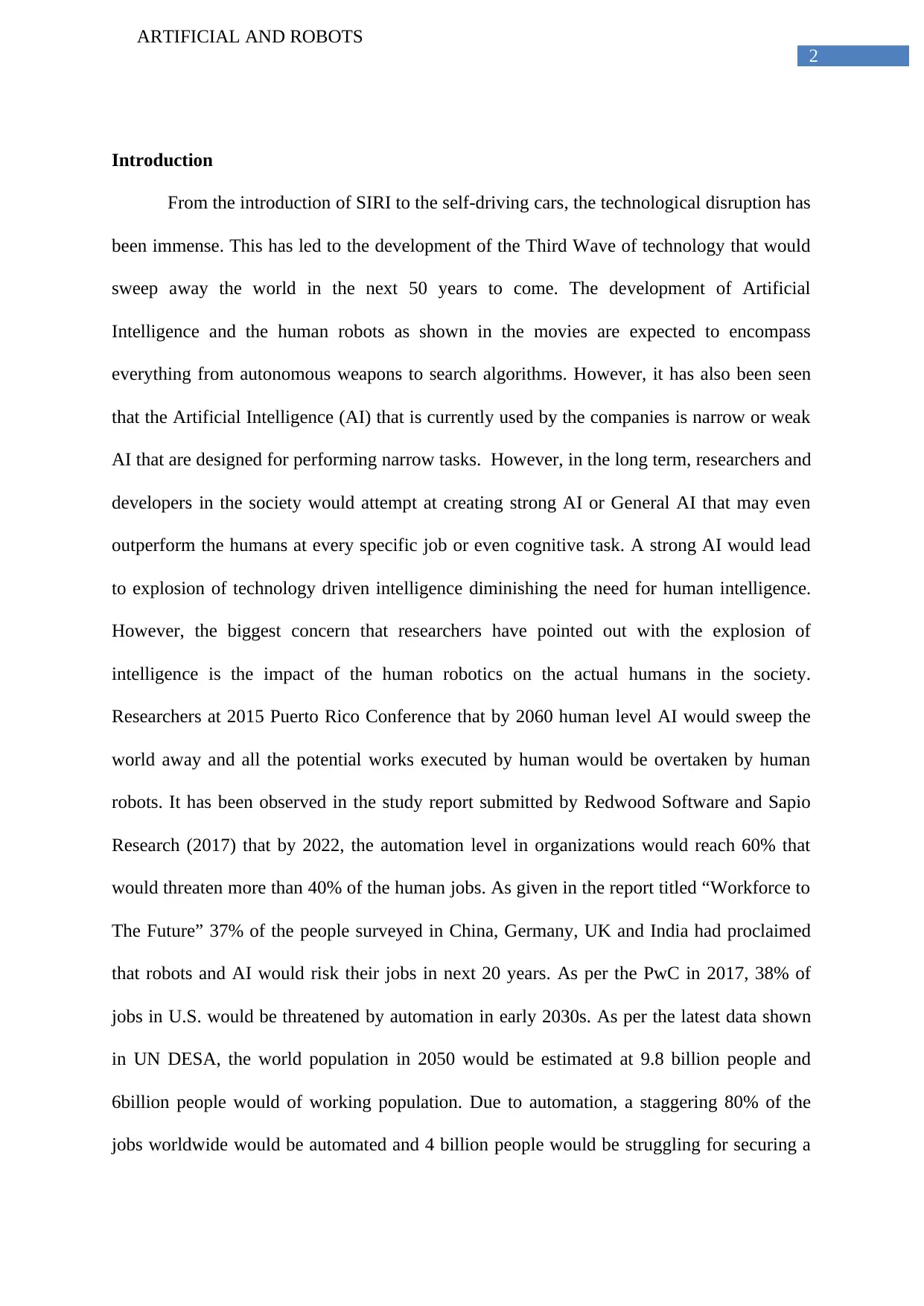
2
ARTIFICIAL AND ROBOTS
Introduction
From the introduction of SIRI to the self-driving cars, the technological disruption has
been immense. This has led to the development of the Third Wave of technology that would
sweep away the world in the next 50 years to come. The development of Artificial
Intelligence and the human robots as shown in the movies are expected to encompass
everything from autonomous weapons to search algorithms. However, it has also been seen
that the Artificial Intelligence (AI) that is currently used by the companies is narrow or weak
AI that are designed for performing narrow tasks. However, in the long term, researchers and
developers in the society would attempt at creating strong AI or General AI that may even
outperform the humans at every specific job or even cognitive task. A strong AI would lead
to explosion of technology driven intelligence diminishing the need for human intelligence.
However, the biggest concern that researchers have pointed out with the explosion of
intelligence is the impact of the human robotics on the actual humans in the society.
Researchers at 2015 Puerto Rico Conference that by 2060 human level AI would sweep the
world away and all the potential works executed by human would be overtaken by human
robots. It has been observed in the study report submitted by Redwood Software and Sapio
Research (2017) that by 2022, the automation level in organizations would reach 60% that
would threaten more than 40% of the human jobs. As given in the report titled “Workforce to
The Future” 37% of the people surveyed in China, Germany, UK and India had proclaimed
that robots and AI would risk their jobs in next 20 years. As per the PwC in 2017, 38% of
jobs in U.S. would be threatened by automation in early 2030s. As per the latest data shown
in UN DESA, the world population in 2050 would be estimated at 9.8 billion people and
6billion people would of working population. Due to automation, a staggering 80% of the
jobs worldwide would be automated and 4 billion people would be struggling for securing a
ARTIFICIAL AND ROBOTS
Introduction
From the introduction of SIRI to the self-driving cars, the technological disruption has
been immense. This has led to the development of the Third Wave of technology that would
sweep away the world in the next 50 years to come. The development of Artificial
Intelligence and the human robots as shown in the movies are expected to encompass
everything from autonomous weapons to search algorithms. However, it has also been seen
that the Artificial Intelligence (AI) that is currently used by the companies is narrow or weak
AI that are designed for performing narrow tasks. However, in the long term, researchers and
developers in the society would attempt at creating strong AI or General AI that may even
outperform the humans at every specific job or even cognitive task. A strong AI would lead
to explosion of technology driven intelligence diminishing the need for human intelligence.
However, the biggest concern that researchers have pointed out with the explosion of
intelligence is the impact of the human robotics on the actual humans in the society.
Researchers at 2015 Puerto Rico Conference that by 2060 human level AI would sweep the
world away and all the potential works executed by human would be overtaken by human
robots. It has been observed in the study report submitted by Redwood Software and Sapio
Research (2017) that by 2022, the automation level in organizations would reach 60% that
would threaten more than 40% of the human jobs. As given in the report titled “Workforce to
The Future” 37% of the people surveyed in China, Germany, UK and India had proclaimed
that robots and AI would risk their jobs in next 20 years. As per the PwC in 2017, 38% of
jobs in U.S. would be threatened by automation in early 2030s. As per the latest data shown
in UN DESA, the world population in 2050 would be estimated at 9.8 billion people and
6billion people would of working population. Due to automation, a staggering 80% of the
jobs worldwide would be automated and 4 billion people would be struggling for securing a
⊘ This is a preview!⊘
Do you want full access?
Subscribe today to unlock all pages.

Trusted by 1+ million students worldwide
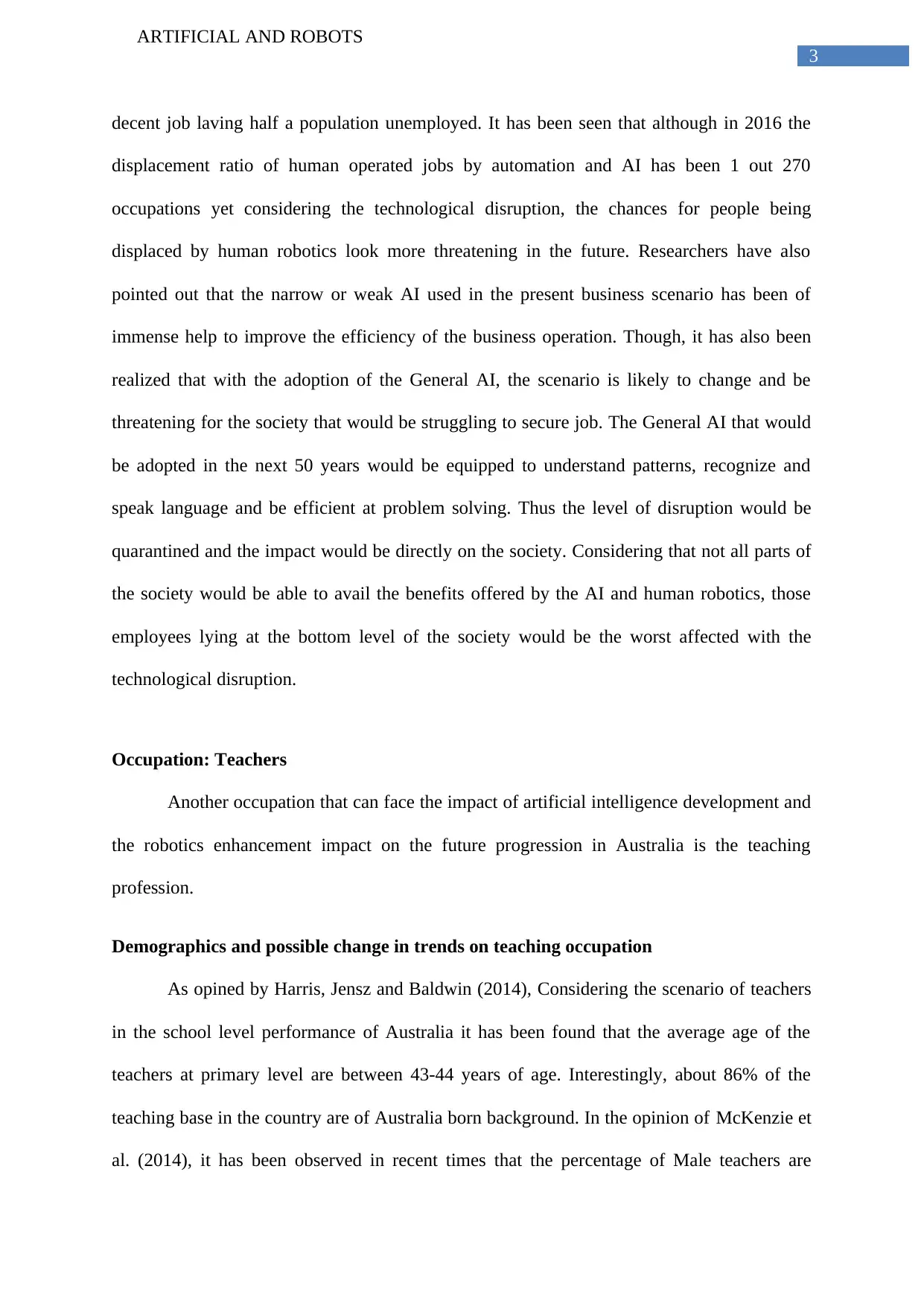
3
ARTIFICIAL AND ROBOTS
decent job laving half a population unemployed. It has been seen that although in 2016 the
displacement ratio of human operated jobs by automation and AI has been 1 out 270
occupations yet considering the technological disruption, the chances for people being
displaced by human robotics look more threatening in the future. Researchers have also
pointed out that the narrow or weak AI used in the present business scenario has been of
immense help to improve the efficiency of the business operation. Though, it has also been
realized that with the adoption of the General AI, the scenario is likely to change and be
threatening for the society that would be struggling to secure job. The General AI that would
be adopted in the next 50 years would be equipped to understand patterns, recognize and
speak language and be efficient at problem solving. Thus the level of disruption would be
quarantined and the impact would be directly on the society. Considering that not all parts of
the society would be able to avail the benefits offered by the AI and human robotics, those
employees lying at the bottom level of the society would be the worst affected with the
technological disruption.
Occupation: Teachers
Another occupation that can face the impact of artificial intelligence development and
the robotics enhancement impact on the future progression in Australia is the teaching
profession.
Demographics and possible change in trends on teaching occupation
As opined by Harris, Jensz and Baldwin (2014), Considering the scenario of teachers
in the school level performance of Australia it has been found that the average age of the
teachers at primary level are between 43-44 years of age. Interestingly, about 86% of the
teaching base in the country are of Australia born background. In the opinion of McKenzie et
al. (2014), it has been observed in recent times that the percentage of Male teachers are
ARTIFICIAL AND ROBOTS
decent job laving half a population unemployed. It has been seen that although in 2016 the
displacement ratio of human operated jobs by automation and AI has been 1 out 270
occupations yet considering the technological disruption, the chances for people being
displaced by human robotics look more threatening in the future. Researchers have also
pointed out that the narrow or weak AI used in the present business scenario has been of
immense help to improve the efficiency of the business operation. Though, it has also been
realized that with the adoption of the General AI, the scenario is likely to change and be
threatening for the society that would be struggling to secure job. The General AI that would
be adopted in the next 50 years would be equipped to understand patterns, recognize and
speak language and be efficient at problem solving. Thus the level of disruption would be
quarantined and the impact would be directly on the society. Considering that not all parts of
the society would be able to avail the benefits offered by the AI and human robotics, those
employees lying at the bottom level of the society would be the worst affected with the
technological disruption.
Occupation: Teachers
Another occupation that can face the impact of artificial intelligence development and
the robotics enhancement impact on the future progression in Australia is the teaching
profession.
Demographics and possible change in trends on teaching occupation
As opined by Harris, Jensz and Baldwin (2014), Considering the scenario of teachers
in the school level performance of Australia it has been found that the average age of the
teachers at primary level are between 43-44 years of age. Interestingly, about 86% of the
teaching base in the country are of Australia born background. In the opinion of McKenzie et
al. (2014), it has been observed in recent times that the percentage of Male teachers are
Paraphrase This Document
Need a fresh take? Get an instant paraphrase of this document with our AI Paraphraser
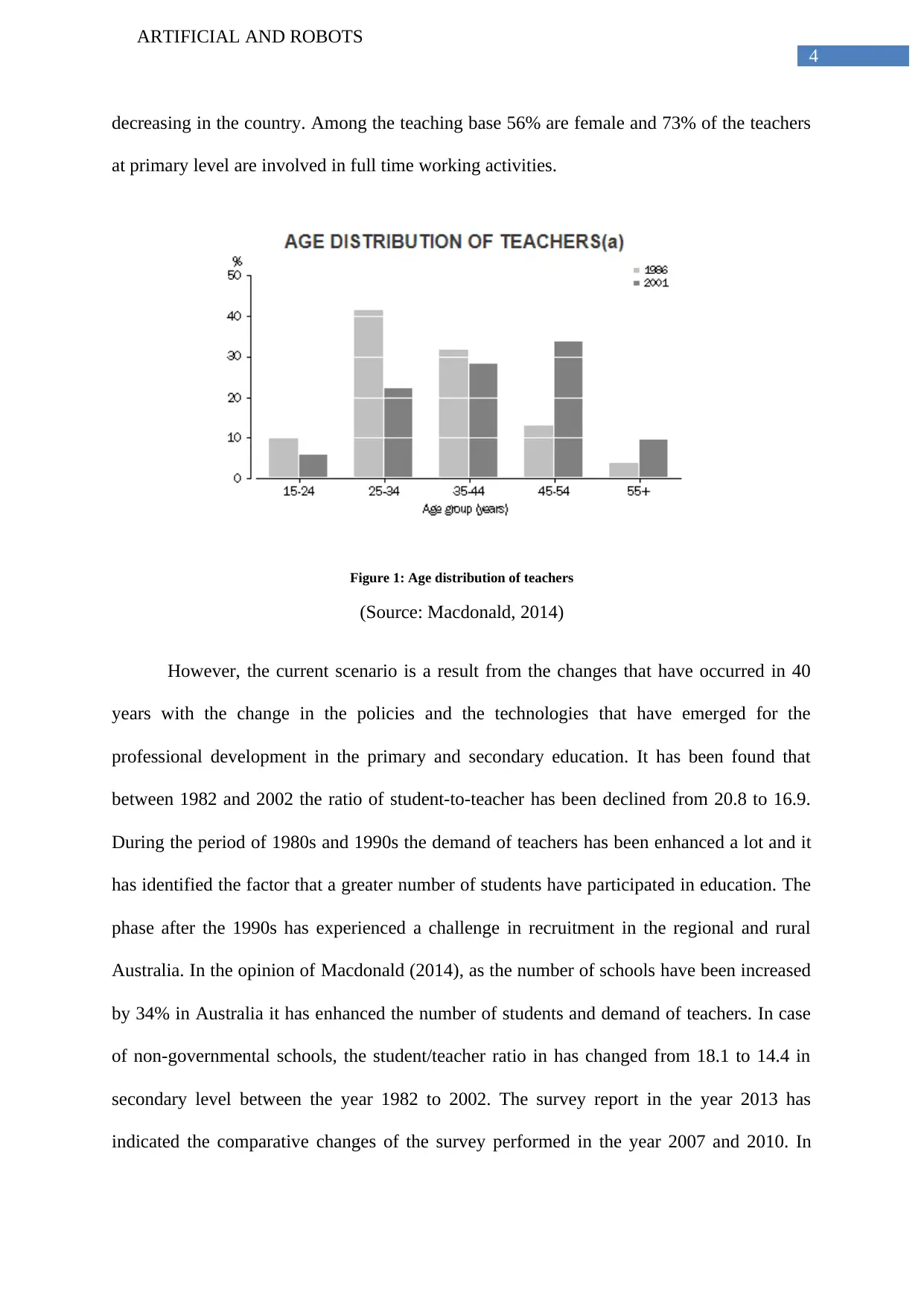
4
ARTIFICIAL AND ROBOTS
decreasing in the country. Among the teaching base 56% are female and 73% of the teachers
at primary level are involved in full time working activities.
Figure 1: Age distribution of teachers
(Source: Macdonald, 2014)
However, the current scenario is a result from the changes that have occurred in 40
years with the change in the policies and the technologies that have emerged for the
professional development in the primary and secondary education. It has been found that
between 1982 and 2002 the ratio of student-to-teacher has been declined from 20.8 to 16.9.
During the period of 1980s and 1990s the demand of teachers has been enhanced a lot and it
has identified the factor that a greater number of students have participated in education. The
phase after the 1990s has experienced a challenge in recruitment in the regional and rural
Australia. In the opinion of Macdonald (2014), as the number of schools have been increased
by 34% in Australia it has enhanced the number of students and demand of teachers. In case
of non-governmental schools, the student/teacher ratio in has changed from 18.1 to 14.4 in
secondary level between the year 1982 to 2002. The survey report in the year 2013 has
indicated the comparative changes of the survey performed in the year 2007 and 2010. In
ARTIFICIAL AND ROBOTS
decreasing in the country. Among the teaching base 56% are female and 73% of the teachers
at primary level are involved in full time working activities.
Figure 1: Age distribution of teachers
(Source: Macdonald, 2014)
However, the current scenario is a result from the changes that have occurred in 40
years with the change in the policies and the technologies that have emerged for the
professional development in the primary and secondary education. It has been found that
between 1982 and 2002 the ratio of student-to-teacher has been declined from 20.8 to 16.9.
During the period of 1980s and 1990s the demand of teachers has been enhanced a lot and it
has identified the factor that a greater number of students have participated in education. The
phase after the 1990s has experienced a challenge in recruitment in the regional and rural
Australia. In the opinion of Macdonald (2014), as the number of schools have been increased
by 34% in Australia it has enhanced the number of students and demand of teachers. In case
of non-governmental schools, the student/teacher ratio in has changed from 18.1 to 14.4 in
secondary level between the year 1982 to 2002. The survey report in the year 2013 has
indicated the comparative changes of the survey performed in the year 2007 and 2010. In
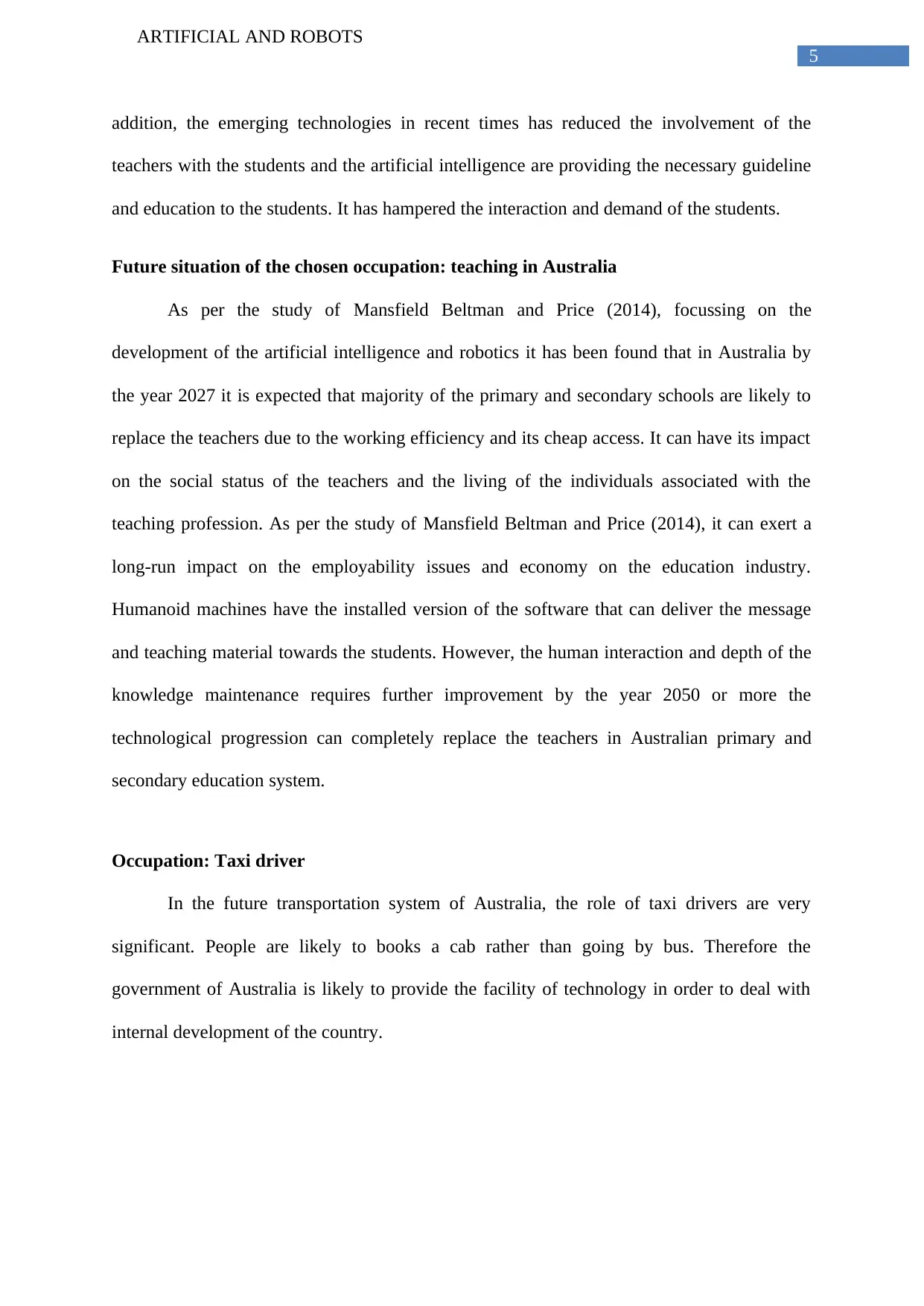
5
ARTIFICIAL AND ROBOTS
addition, the emerging technologies in recent times has reduced the involvement of the
teachers with the students and the artificial intelligence are providing the necessary guideline
and education to the students. It has hampered the interaction and demand of the students.
Future situation of the chosen occupation: teaching in Australia
As per the study of Mansfield Beltman and Price (2014), focussing on the
development of the artificial intelligence and robotics it has been found that in Australia by
the year 2027 it is expected that majority of the primary and secondary schools are likely to
replace the teachers due to the working efficiency and its cheap access. It can have its impact
on the social status of the teachers and the living of the individuals associated with the
teaching profession. As per the study of Mansfield Beltman and Price (2014), it can exert a
long-run impact on the employability issues and economy on the education industry.
Humanoid machines have the installed version of the software that can deliver the message
and teaching material towards the students. However, the human interaction and depth of the
knowledge maintenance requires further improvement by the year 2050 or more the
technological progression can completely replace the teachers in Australian primary and
secondary education system.
Occupation: Taxi driver
In the future transportation system of Australia, the role of taxi drivers are very
significant. People are likely to books a cab rather than going by bus. Therefore the
government of Australia is likely to provide the facility of technology in order to deal with
internal development of the country.
ARTIFICIAL AND ROBOTS
addition, the emerging technologies in recent times has reduced the involvement of the
teachers with the students and the artificial intelligence are providing the necessary guideline
and education to the students. It has hampered the interaction and demand of the students.
Future situation of the chosen occupation: teaching in Australia
As per the study of Mansfield Beltman and Price (2014), focussing on the
development of the artificial intelligence and robotics it has been found that in Australia by
the year 2027 it is expected that majority of the primary and secondary schools are likely to
replace the teachers due to the working efficiency and its cheap access. It can have its impact
on the social status of the teachers and the living of the individuals associated with the
teaching profession. As per the study of Mansfield Beltman and Price (2014), it can exert a
long-run impact on the employability issues and economy on the education industry.
Humanoid machines have the installed version of the software that can deliver the message
and teaching material towards the students. However, the human interaction and depth of the
knowledge maintenance requires further improvement by the year 2050 or more the
technological progression can completely replace the teachers in Australian primary and
secondary education system.
Occupation: Taxi driver
In the future transportation system of Australia, the role of taxi drivers are very
significant. People are likely to books a cab rather than going by bus. Therefore the
government of Australia is likely to provide the facility of technology in order to deal with
internal development of the country.
⊘ This is a preview!⊘
Do you want full access?
Subscribe today to unlock all pages.

Trusted by 1+ million students worldwide
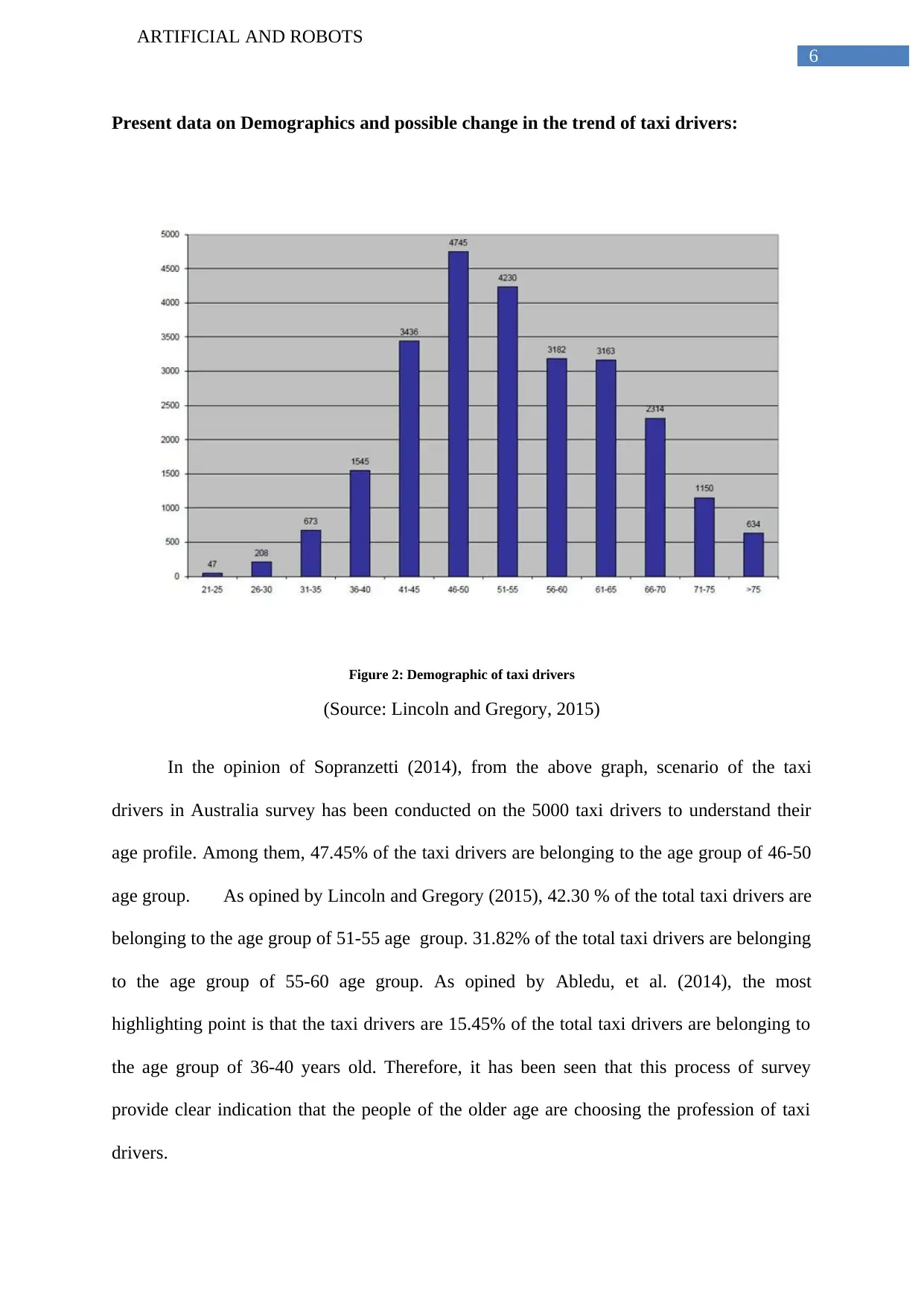
6
ARTIFICIAL AND ROBOTS
Present data on Demographics and possible change in the trend of taxi drivers:
Figure 2: Demographic of taxi drivers
(Source: Lincoln and Gregory, 2015)
In the opinion of Sopranzetti (2014), from the above graph, scenario of the taxi
drivers in Australia survey has been conducted on the 5000 taxi drivers to understand their
age profile. Among them, 47.45% of the taxi drivers are belonging to the age group of 46-50
age group. As opined by Lincoln and Gregory (2015), 42.30 % of the total taxi drivers are
belonging to the age group of 51-55 age group. 31.82% of the total taxi drivers are belonging
to the age group of 55-60 age group. As opined by Abledu, et al. (2014), the most
highlighting point is that the taxi drivers are 15.45% of the total taxi drivers are belonging to
the age group of 36-40 years old. Therefore, it has been seen that this process of survey
provide clear indication that the people of the older age are choosing the profession of taxi
drivers.
ARTIFICIAL AND ROBOTS
Present data on Demographics and possible change in the trend of taxi drivers:
Figure 2: Demographic of taxi drivers
(Source: Lincoln and Gregory, 2015)
In the opinion of Sopranzetti (2014), from the above graph, scenario of the taxi
drivers in Australia survey has been conducted on the 5000 taxi drivers to understand their
age profile. Among them, 47.45% of the taxi drivers are belonging to the age group of 46-50
age group. As opined by Lincoln and Gregory (2015), 42.30 % of the total taxi drivers are
belonging to the age group of 51-55 age group. 31.82% of the total taxi drivers are belonging
to the age group of 55-60 age group. As opined by Abledu, et al. (2014), the most
highlighting point is that the taxi drivers are 15.45% of the total taxi drivers are belonging to
the age group of 36-40 years old. Therefore, it has been seen that this process of survey
provide clear indication that the people of the older age are choosing the profession of taxi
drivers.
Paraphrase This Document
Need a fresh take? Get an instant paraphrase of this document with our AI Paraphraser
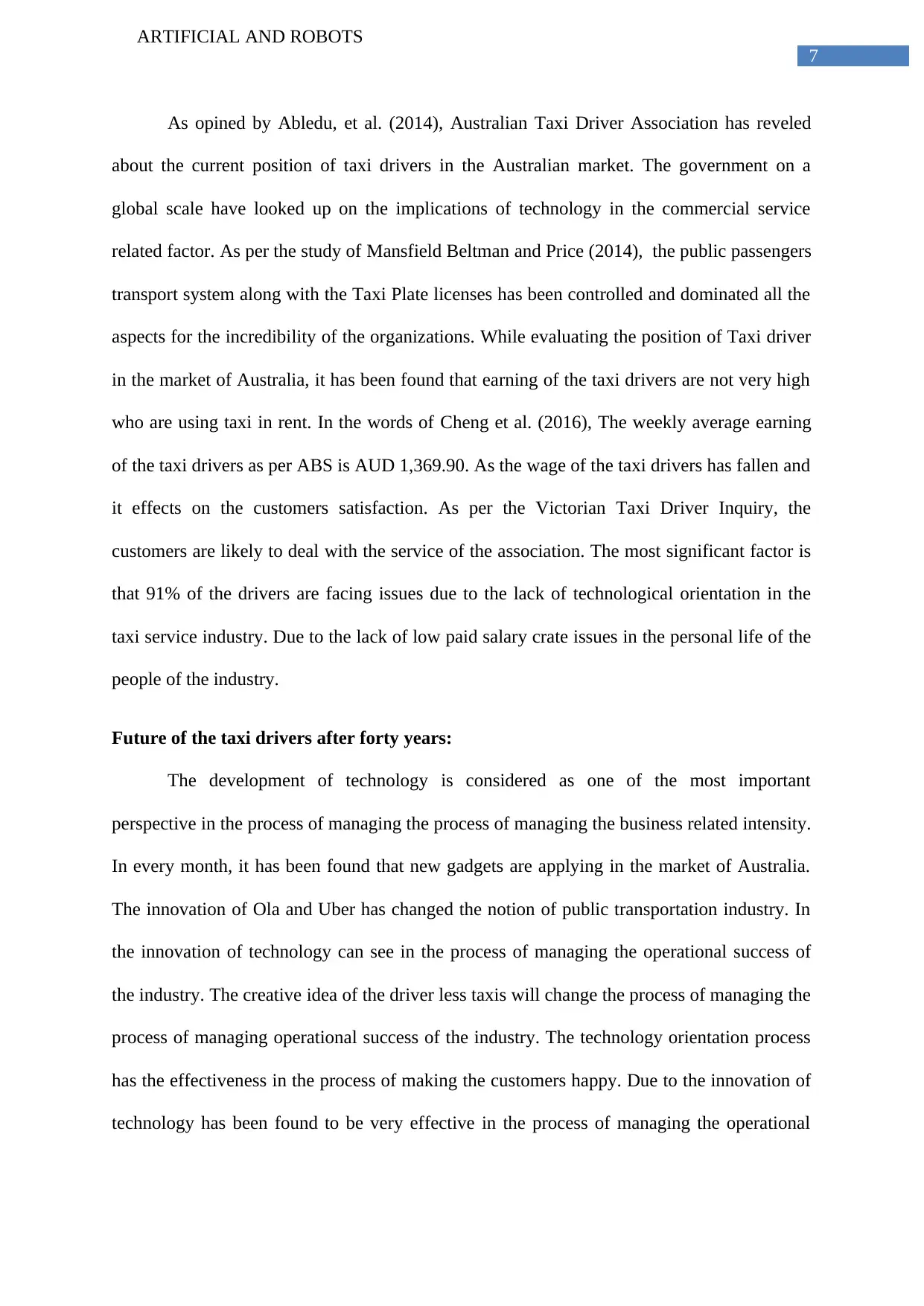
7
ARTIFICIAL AND ROBOTS
As opined by Abledu, et al. (2014), Australian Taxi Driver Association has reveled
about the current position of taxi drivers in the Australian market. The government on a
global scale have looked up on the implications of technology in the commercial service
related factor. As per the study of Mansfield Beltman and Price (2014), the public passengers
transport system along with the Taxi Plate licenses has been controlled and dominated all the
aspects for the incredibility of the organizations. While evaluating the position of Taxi driver
in the market of Australia, it has been found that earning of the taxi drivers are not very high
who are using taxi in rent. In the words of Cheng et al. (2016), The weekly average earning
of the taxi drivers as per ABS is AUD 1,369.90. As the wage of the taxi drivers has fallen and
it effects on the customers satisfaction. As per the Victorian Taxi Driver Inquiry, the
customers are likely to deal with the service of the association. The most significant factor is
that 91% of the drivers are facing issues due to the lack of technological orientation in the
taxi service industry. Due to the lack of low paid salary crate issues in the personal life of the
people of the industry.
Future of the taxi drivers after forty years:
The development of technology is considered as one of the most important
perspective in the process of managing the process of managing the business related intensity.
In every month, it has been found that new gadgets are applying in the market of Australia.
The innovation of Ola and Uber has changed the notion of public transportation industry. In
the innovation of technology can see in the process of managing the operational success of
the industry. The creative idea of the driver less taxis will change the process of managing the
process of managing operational success of the industry. The technology orientation process
has the effectiveness in the process of making the customers happy. Due to the innovation of
technology has been found to be very effective in the process of managing the operational
ARTIFICIAL AND ROBOTS
As opined by Abledu, et al. (2014), Australian Taxi Driver Association has reveled
about the current position of taxi drivers in the Australian market. The government on a
global scale have looked up on the implications of technology in the commercial service
related factor. As per the study of Mansfield Beltman and Price (2014), the public passengers
transport system along with the Taxi Plate licenses has been controlled and dominated all the
aspects for the incredibility of the organizations. While evaluating the position of Taxi driver
in the market of Australia, it has been found that earning of the taxi drivers are not very high
who are using taxi in rent. In the words of Cheng et al. (2016), The weekly average earning
of the taxi drivers as per ABS is AUD 1,369.90. As the wage of the taxi drivers has fallen and
it effects on the customers satisfaction. As per the Victorian Taxi Driver Inquiry, the
customers are likely to deal with the service of the association. The most significant factor is
that 91% of the drivers are facing issues due to the lack of technological orientation in the
taxi service industry. Due to the lack of low paid salary crate issues in the personal life of the
people of the industry.
Future of the taxi drivers after forty years:
The development of technology is considered as one of the most important
perspective in the process of managing the process of managing the business related intensity.
In every month, it has been found that new gadgets are applying in the market of Australia.
The innovation of Ola and Uber has changed the notion of public transportation industry. In
the innovation of technology can see in the process of managing the operational success of
the industry. The creative idea of the driver less taxis will change the process of managing the
process of managing operational success of the industry. The technology orientation process
has the effectiveness in the process of making the customers happy. Due to the innovation of
technology has been found to be very effective in the process of managing the operational
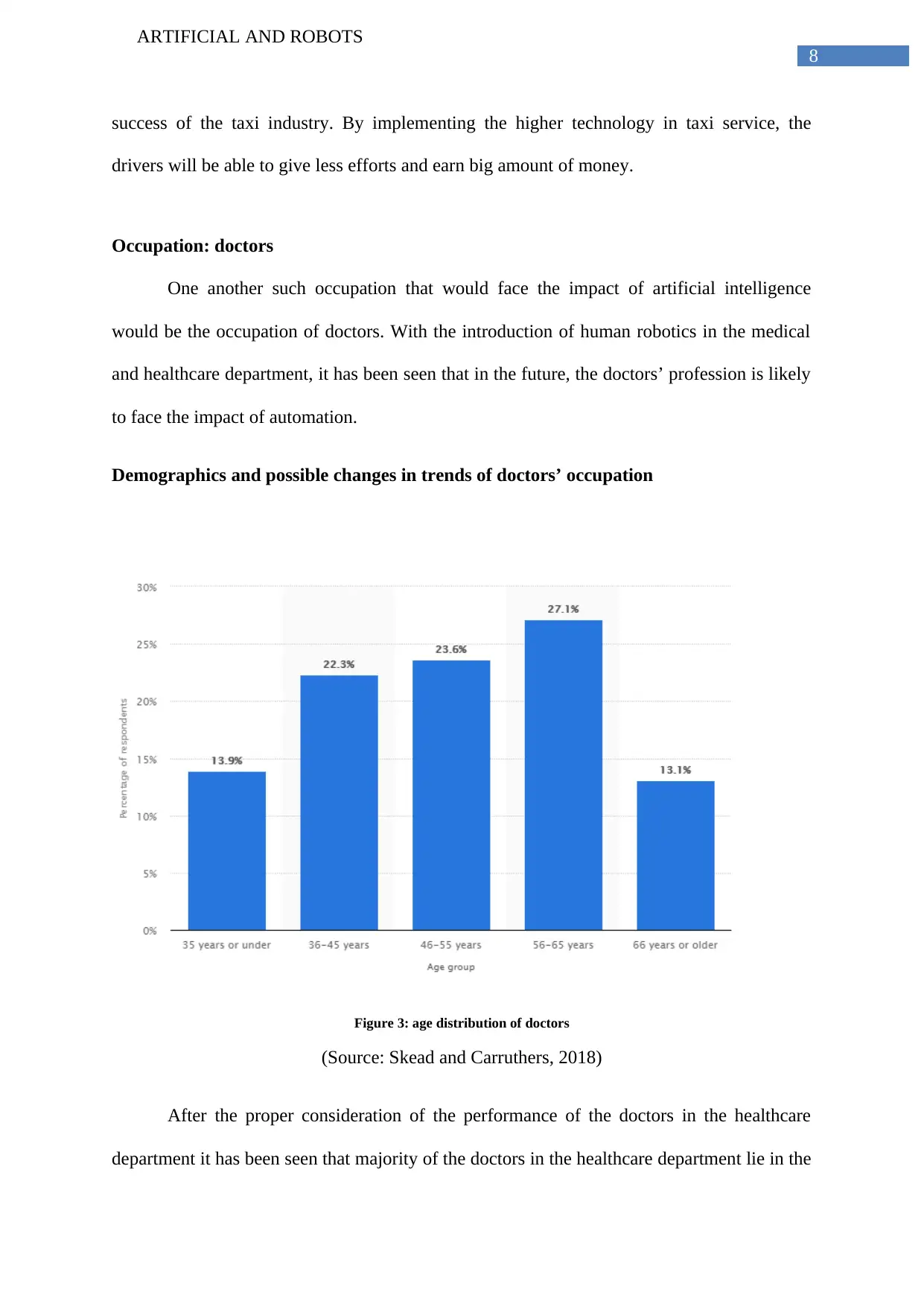
8
ARTIFICIAL AND ROBOTS
success of the taxi industry. By implementing the higher technology in taxi service, the
drivers will be able to give less efforts and earn big amount of money.
Occupation: doctors
One another such occupation that would face the impact of artificial intelligence
would be the occupation of doctors. With the introduction of human robotics in the medical
and healthcare department, it has been seen that in the future, the doctors’ profession is likely
to face the impact of automation.
Demographics and possible changes in trends of doctors’ occupation
Figure 3: age distribution of doctors
(Source: Skead and Carruthers, 2018)
After the proper consideration of the performance of the doctors in the healthcare
department it has been seen that majority of the doctors in the healthcare department lie in the
ARTIFICIAL AND ROBOTS
success of the taxi industry. By implementing the higher technology in taxi service, the
drivers will be able to give less efforts and earn big amount of money.
Occupation: doctors
One another such occupation that would face the impact of artificial intelligence
would be the occupation of doctors. With the introduction of human robotics in the medical
and healthcare department, it has been seen that in the future, the doctors’ profession is likely
to face the impact of automation.
Demographics and possible changes in trends of doctors’ occupation
Figure 3: age distribution of doctors
(Source: Skead and Carruthers, 2018)
After the proper consideration of the performance of the doctors in the healthcare
department it has been seen that majority of the doctors in the healthcare department lie in the
⊘ This is a preview!⊘
Do you want full access?
Subscribe today to unlock all pages.

Trusted by 1+ million students worldwide
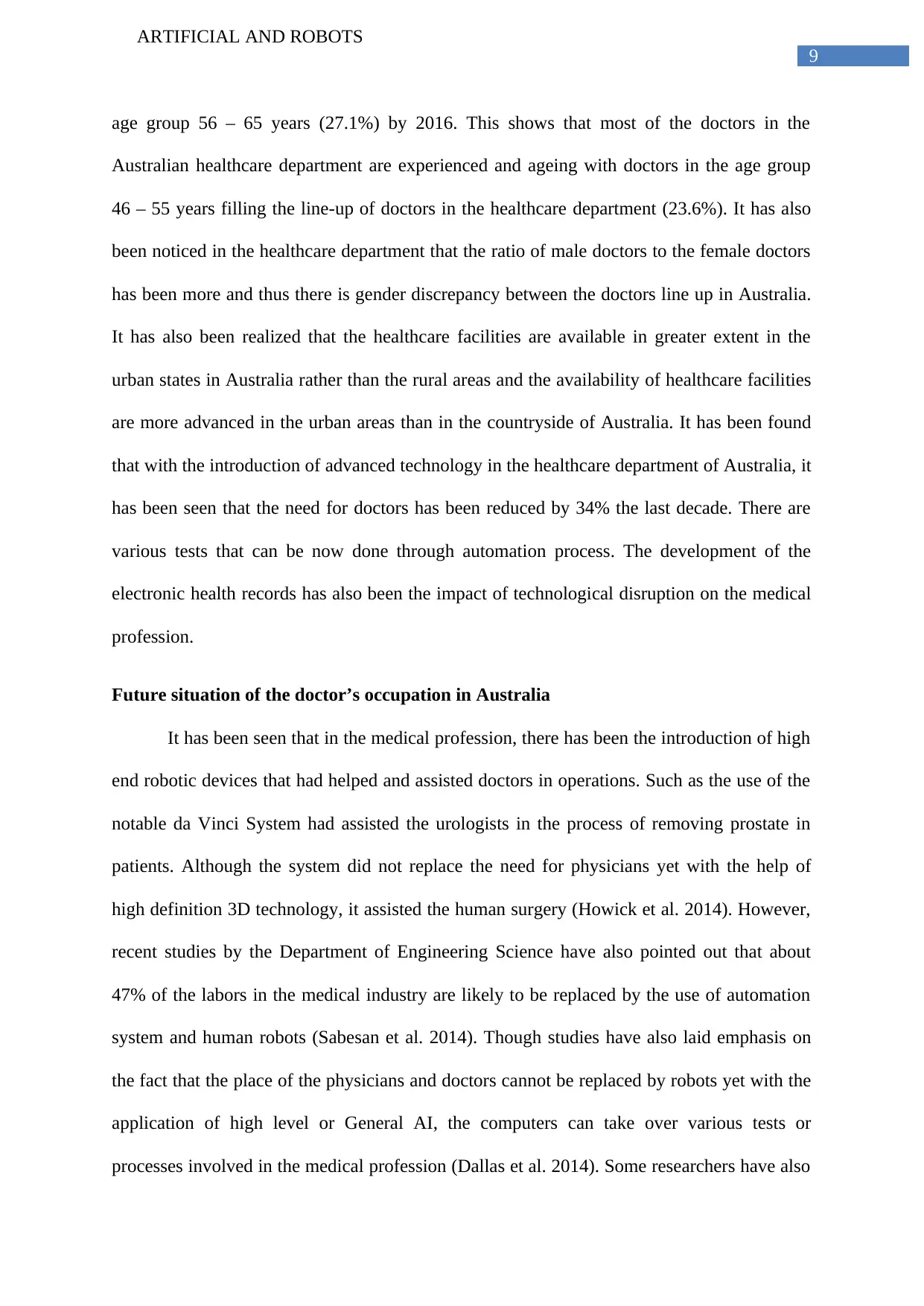
9
ARTIFICIAL AND ROBOTS
age group 56 – 65 years (27.1%) by 2016. This shows that most of the doctors in the
Australian healthcare department are experienced and ageing with doctors in the age group
46 – 55 years filling the line-up of doctors in the healthcare department (23.6%). It has also
been noticed in the healthcare department that the ratio of male doctors to the female doctors
has been more and thus there is gender discrepancy between the doctors line up in Australia.
It has also been realized that the healthcare facilities are available in greater extent in the
urban states in Australia rather than the rural areas and the availability of healthcare facilities
are more advanced in the urban areas than in the countryside of Australia. It has been found
that with the introduction of advanced technology in the healthcare department of Australia, it
has been seen that the need for doctors has been reduced by 34% the last decade. There are
various tests that can be now done through automation process. The development of the
electronic health records has also been the impact of technological disruption on the medical
profession.
Future situation of the doctor’s occupation in Australia
It has been seen that in the medical profession, there has been the introduction of high
end robotic devices that had helped and assisted doctors in operations. Such as the use of the
notable da Vinci System had assisted the urologists in the process of removing prostate in
patients. Although the system did not replace the need for physicians yet with the help of
high definition 3D technology, it assisted the human surgery (Howick et al. 2014). However,
recent studies by the Department of Engineering Science have also pointed out that about
47% of the labors in the medical industry are likely to be replaced by the use of automation
system and human robots (Sabesan et al. 2014). Though studies have also laid emphasis on
the fact that the place of the physicians and doctors cannot be replaced by robots yet with the
application of high level or General AI, the computers can take over various tests or
processes involved in the medical profession (Dallas et al. 2014). Some researchers have also
ARTIFICIAL AND ROBOTS
age group 56 – 65 years (27.1%) by 2016. This shows that most of the doctors in the
Australian healthcare department are experienced and ageing with doctors in the age group
46 – 55 years filling the line-up of doctors in the healthcare department (23.6%). It has also
been noticed in the healthcare department that the ratio of male doctors to the female doctors
has been more and thus there is gender discrepancy between the doctors line up in Australia.
It has also been realized that the healthcare facilities are available in greater extent in the
urban states in Australia rather than the rural areas and the availability of healthcare facilities
are more advanced in the urban areas than in the countryside of Australia. It has been found
that with the introduction of advanced technology in the healthcare department of Australia, it
has been seen that the need for doctors has been reduced by 34% the last decade. There are
various tests that can be now done through automation process. The development of the
electronic health records has also been the impact of technological disruption on the medical
profession.
Future situation of the doctor’s occupation in Australia
It has been seen that in the medical profession, there has been the introduction of high
end robotic devices that had helped and assisted doctors in operations. Such as the use of the
notable da Vinci System had assisted the urologists in the process of removing prostate in
patients. Although the system did not replace the need for physicians yet with the help of
high definition 3D technology, it assisted the human surgery (Howick et al. 2014). However,
recent studies by the Department of Engineering Science have also pointed out that about
47% of the labors in the medical industry are likely to be replaced by the use of automation
system and human robots (Sabesan et al. 2014). Though studies have also laid emphasis on
the fact that the place of the physicians and doctors cannot be replaced by robots yet with the
application of high level or General AI, the computers can take over various tests or
processes involved in the medical profession (Dallas et al. 2014). Some researchers have also
Paraphrase This Document
Need a fresh take? Get an instant paraphrase of this document with our AI Paraphraser
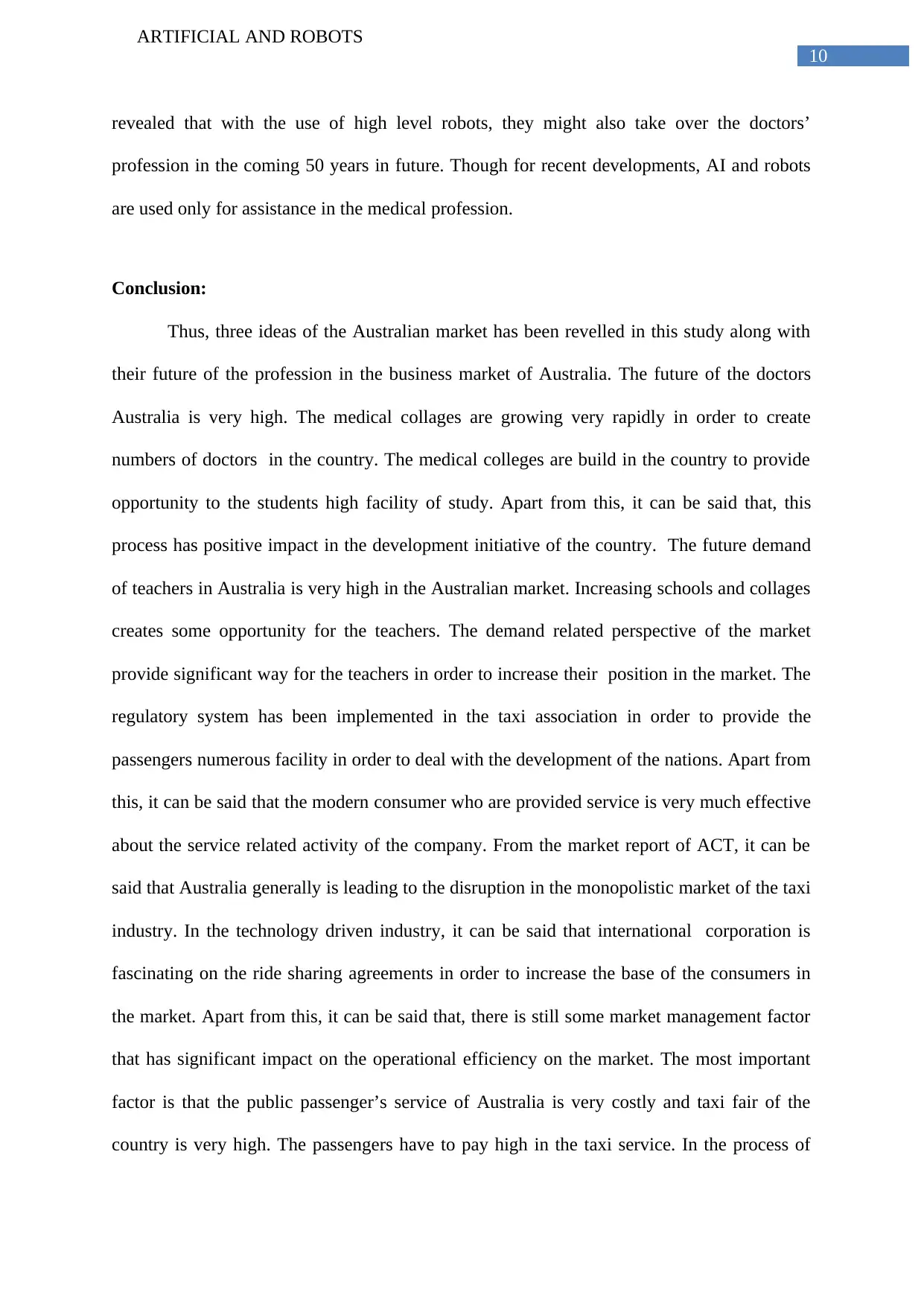
10
ARTIFICIAL AND ROBOTS
revealed that with the use of high level robots, they might also take over the doctors’
profession in the coming 50 years in future. Though for recent developments, AI and robots
are used only for assistance in the medical profession.
Conclusion:
Thus, three ideas of the Australian market has been revelled in this study along with
their future of the profession in the business market of Australia. The future of the doctors
Australia is very high. The medical collages are growing very rapidly in order to create
numbers of doctors in the country. The medical colleges are build in the country to provide
opportunity to the students high facility of study. Apart from this, it can be said that, this
process has positive impact in the development initiative of the country. The future demand
of teachers in Australia is very high in the Australian market. Increasing schools and collages
creates some opportunity for the teachers. The demand related perspective of the market
provide significant way for the teachers in order to increase their position in the market. The
regulatory system has been implemented in the taxi association in order to provide the
passengers numerous facility in order to deal with the development of the nations. Apart from
this, it can be said that the modern consumer who are provided service is very much effective
about the service related activity of the company. From the market report of ACT, it can be
said that Australia generally is leading to the disruption in the monopolistic market of the taxi
industry. In the technology driven industry, it can be said that international corporation is
fascinating on the ride sharing agreements in order to increase the base of the consumers in
the market. Apart from this, it can be said that, there is still some market management factor
that has significant impact on the operational efficiency on the market. The most important
factor is that the public passenger’s service of Australia is very costly and taxi fair of the
country is very high. The passengers have to pay high in the taxi service. In the process of
ARTIFICIAL AND ROBOTS
revealed that with the use of high level robots, they might also take over the doctors’
profession in the coming 50 years in future. Though for recent developments, AI and robots
are used only for assistance in the medical profession.
Conclusion:
Thus, three ideas of the Australian market has been revelled in this study along with
their future of the profession in the business market of Australia. The future of the doctors
Australia is very high. The medical collages are growing very rapidly in order to create
numbers of doctors in the country. The medical colleges are build in the country to provide
opportunity to the students high facility of study. Apart from this, it can be said that, this
process has positive impact in the development initiative of the country. The future demand
of teachers in Australia is very high in the Australian market. Increasing schools and collages
creates some opportunity for the teachers. The demand related perspective of the market
provide significant way for the teachers in order to increase their position in the market. The
regulatory system has been implemented in the taxi association in order to provide the
passengers numerous facility in order to deal with the development of the nations. Apart from
this, it can be said that the modern consumer who are provided service is very much effective
about the service related activity of the company. From the market report of ACT, it can be
said that Australia generally is leading to the disruption in the monopolistic market of the taxi
industry. In the technology driven industry, it can be said that international corporation is
fascinating on the ride sharing agreements in order to increase the base of the consumers in
the market. Apart from this, it can be said that, there is still some market management factor
that has significant impact on the operational efficiency on the market. The most important
factor is that the public passenger’s service of Australia is very costly and taxi fair of the
country is very high. The passengers have to pay high in the taxi service. In the process of
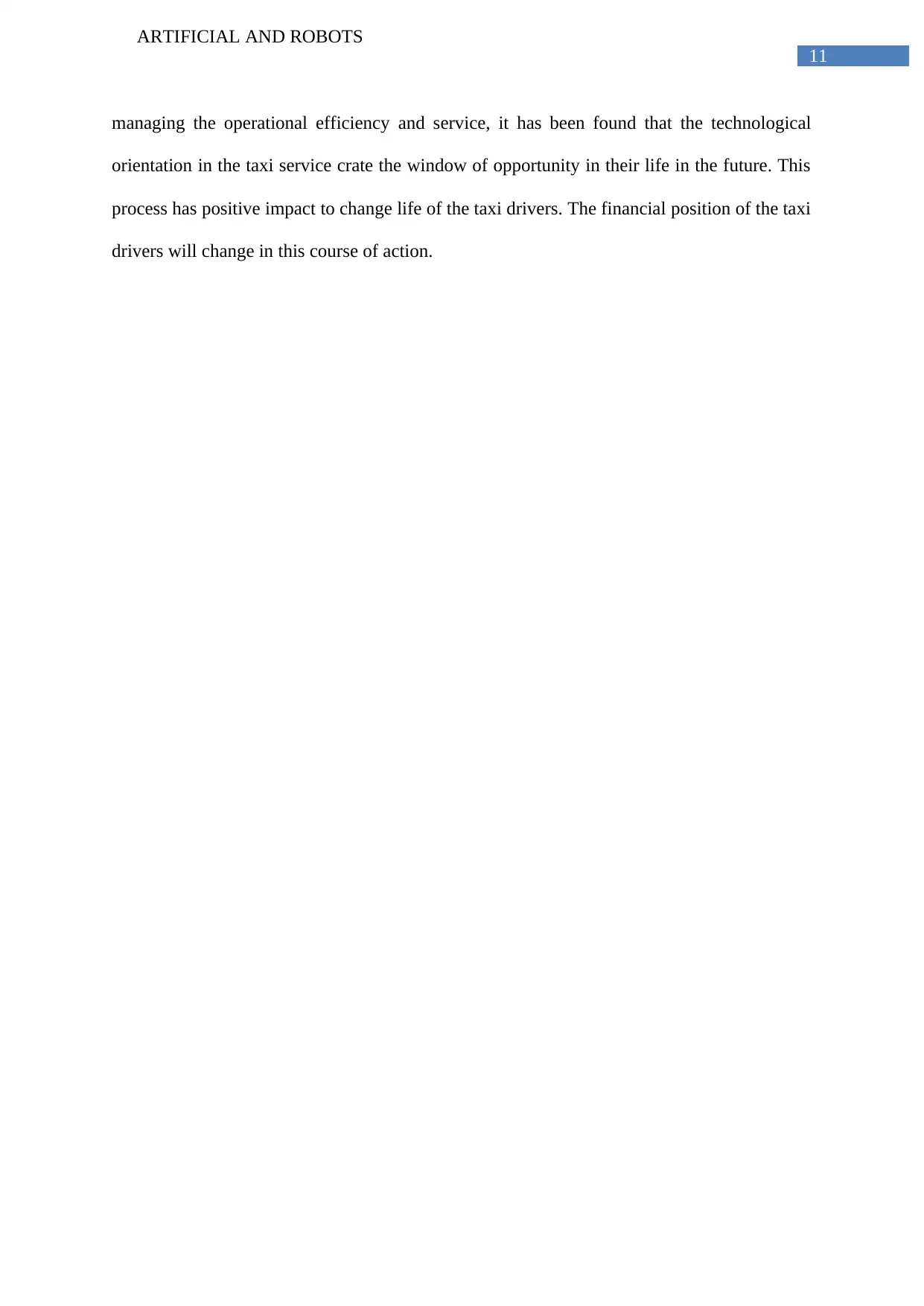
11
ARTIFICIAL AND ROBOTS
managing the operational efficiency and service, it has been found that the technological
orientation in the taxi service crate the window of opportunity in their life in the future. This
process has positive impact to change life of the taxi drivers. The financial position of the taxi
drivers will change in this course of action.
ARTIFICIAL AND ROBOTS
managing the operational efficiency and service, it has been found that the technological
orientation in the taxi service crate the window of opportunity in their life in the future. This
process has positive impact to change life of the taxi drivers. The financial position of the taxi
drivers will change in this course of action.
⊘ This is a preview!⊘
Do you want full access?
Subscribe today to unlock all pages.

Trusted by 1+ million students worldwide
1 out of 14
Related Documents
Your All-in-One AI-Powered Toolkit for Academic Success.
+13062052269
info@desklib.com
Available 24*7 on WhatsApp / Email
![[object Object]](/_next/static/media/star-bottom.7253800d.svg)
Unlock your academic potential
Copyright © 2020–2025 A2Z Services. All Rights Reserved. Developed and managed by ZUCOL.





